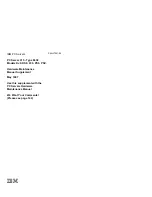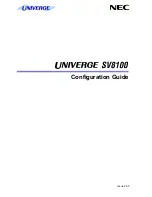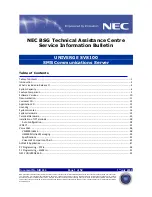
Related service infor mation
259
Observe the special safety precautions when you work with very high voltages;
these instructions are in the safety sections of maintenance information. Use
extreme care when measuring high voltages.
•
Regularly inspect and maintain your electrical hand tools for safe operational
condition.
•
Do not use worn or broken tools and testers.
•
Never assume
that power has been disconnected from a circuit. First,
check
that it
has been powered-off.
•
Always look carefully for possible hazards in your work area. Examples of these
hazards are moist floors, nongrounded power extension cables, power surges,
and missing safety grounds.
•
Do not touch live electrical circuits with the reflective surface of a plastic dental
mirror. The surface is conductive; such touching can cause personal injury and
machine damage.
•
Do not service the following parts with the power on when they are removed
from their normal operating places in a machine:
— Power supply units
— Pumps
— Blowers and fans
— Motor generators
and similar units. (This practice ensures correct grounding of the units.)
•
If an electrical accident occurs:
— Use caution; do not become a victim yourself.
— Switch off power.
— Send another person to get medical aid.
Safety inspection guide
The intent of this inspection guide is to assist you in identifying potentially unsafe
conditions on these products. Each machine, as it was designed and built, had
required safety items installed to protect users and service personnel from injury. This
guide addresses only those items. However, good judgment should be used to
identify potential safety hazards due to attachment of non-IBM features or options not
covered by this inspection guide.
If any unsafe conditions are present, you must determine how serious the apparent
hazard could be and whether you can continue without first correcting the problem.
Consider these conditions and the safety hazards they present:
•
Electrical hazards, especially primary power (primary voltage on the frame can
cause serious or fatal electrical shock).
•
Explosive hazards, such as a damaged CRT face or bulging capacitor
•
Mechanical hazards, such as loose or missing hardware
The guide consists of a series of steps presented in a checklist. Begin the checks with
the power off, and the power cord disconnected.
Checklist:
1.
Check exterior covers for damage (loose, broken, or sharp edges).
Summary of Contents for xSeries 380
Page 1: ...IBM Hardware Maintenance Manual xSeries 380 ...
Page 2: ......
Page 3: ...IBM Hardware Maintenance Manual xSeries 380 ...
Page 10: ...viii Hardware Maintenance Manual xSeries 380 ...
Page 24: ...14 Hardware MaintenanceManual xSeries 380 ...
Page 94: ...84 Hardware MaintenanceManual xSeries 380 ...
Page 236: ...226 Hardware Maintenance Manual xSeries 380 ...
Page 262: ...252 Hardware Maintenance Manual xSeries 380 Processor memory complex 1 2 3 4 5 6 7 ...
Page 277: ...Related serviceinformation 267 Statement 17 The following label indicates moving parts nearby ...
Page 283: ...Related serviceinformation 273 ...
Page 284: ...274 Hardware Maintenance Manual xSeries 380 ...
Page 285: ...Related serviceinformation 275 ...
Page 286: ...276 Hardware Maintenance Manual xSeries 380 ...
Page 287: ...Related serviceinformation 277 ...
Page 288: ...278 Hardware Maintenance Manual xSeries 380 ...
Page 289: ...Related serviceinformation 279 ...
Page 290: ...280 Hardware Maintenance Manual xSeries 380 ...
Page 291: ...Related serviceinformation 281 ...
Page 292: ...282 Hardware Maintenance Manual xSeries 380 ...
Page 309: ...Related serviceinformation 299 ...
Page 310: ...300 Hardware Maintenance Manual xSeries 380 ...
Page 311: ...Related serviceinformation 301 ...
Page 312: ...302 Hardware Maintenance Manual xSeries 380 ...
Page 322: ...312 Hardware Maintenance Manual xSeries 380 ...
Page 323: ......
















































